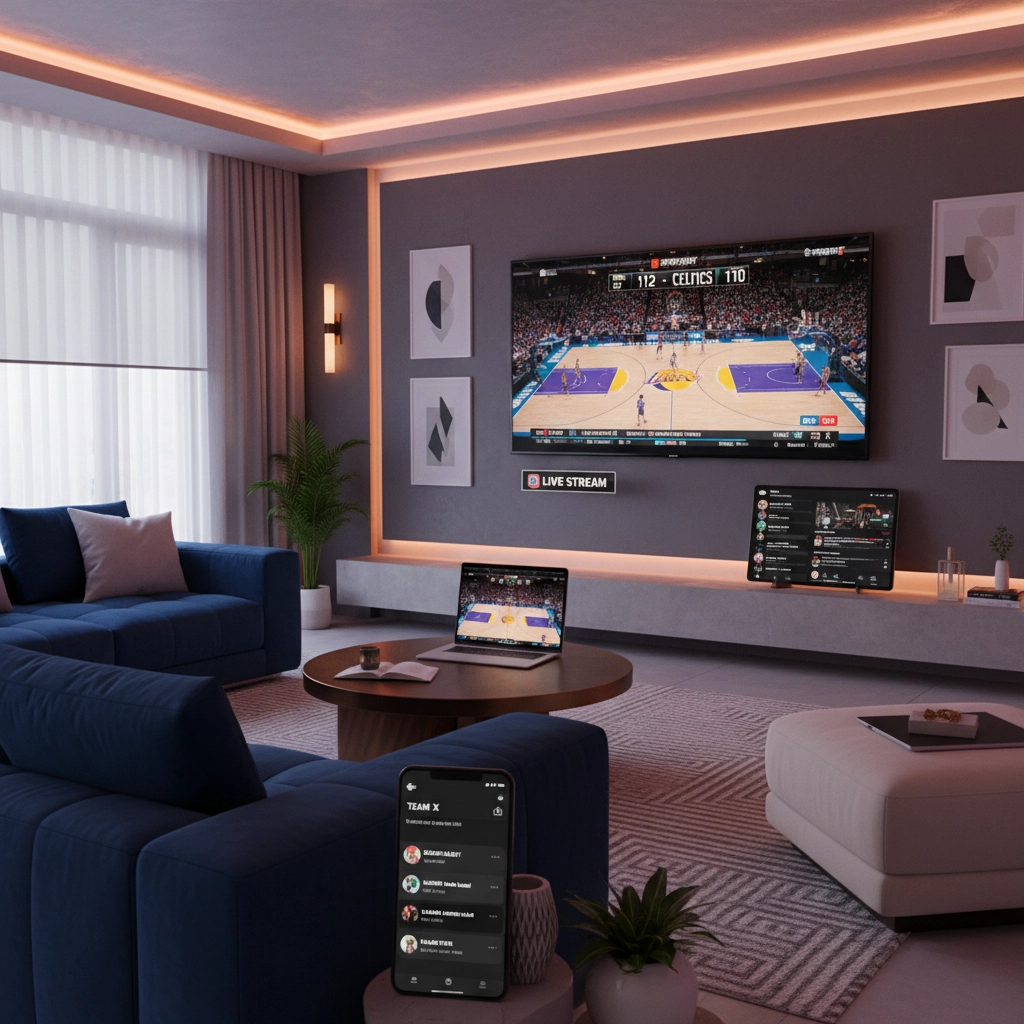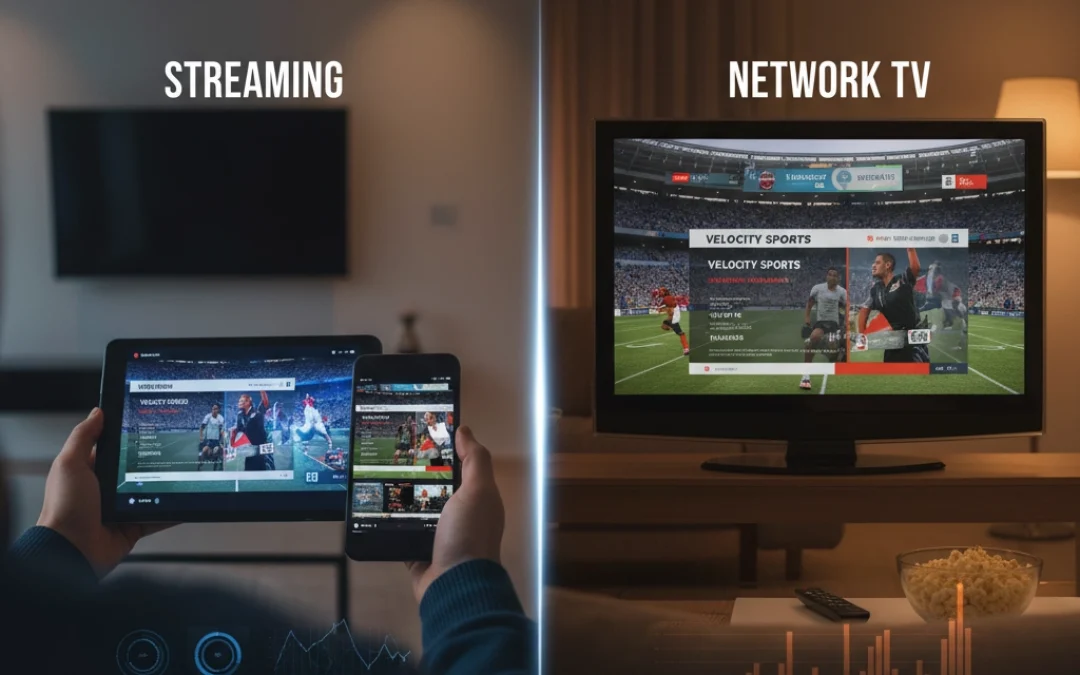You're sitting there with your sports advertising budget, wondering where to put your money for maximum impact. Network TV or streaming? The answer isn't as straightforward as the industry wants you to believe, and it's exactly why smart brands are turning to hybrid approaches that blend the best of both worlds.
At SportsMedia.tv, we've seen countless campaigns succeed and fail across both platforms. Here's what the numbers actually tell us about ROI, and more importantly, how you can use this data to make decisions that drive real results.
The Network TV Powerhouse: Mass Reach That Still Delivers
Network television isn't dead, it's just misunderstood. When you look at the raw ROI numbers, traditional TV advertising delivers an impressive $4.90 in revenue for every dollar spent. But here's where it gets interesting: properly optimized TV campaigns can push that return between 300-500% ROI, significantly outperforming most digital alternatives.
The reason? Sustained attention and credibility. When sports fans are watching live games on network TV, they're locked in. No scrolling, no second-screening (well, mostly), just focused engagement with your brand message. This translates to TV contributing 18% toward overall sales impact compared to digital channels at 11%.

Network TV's mass reach creates something digital struggles to replicate: universal brand recognition. When your ad runs during a major sporting event, you're not just reaching your target demographic: you're becoming part of the cultural conversation. That water cooler effect still matters, especially for brands building long-term equity.
But let's be honest about the downsides. Network TV requires substantial minimum budgets that can strain smaller campaigns. The targeting is broad-brush at best, and measuring direct response proves challenging compared to digital's granular analytics.
Streaming's Precision Game: Targeted Efficiency at Scale
Streaming platforms flip the script entirely. Instead of mass reach, you get surgical precision in targeting sports fans based on viewing habits, demographics, and real-time behavior. The cost efficiency is undeniable: streaming typically offers lower CPMs with the flexibility to adjust budgets on the fly.
Here's what streaming does exceptionally well: engagement rates. Viewers actively choose their content, creating a more receptive environment for advertising. Interactive ad formats like clickable overlays can drive immediate action, something network TV simply cannot match.
The real-time optimization capabilities of streaming platforms give you unprecedented control. Campaign performing poorly during the first quarter? Adjust creative, targeting, or budget allocation before halftime. This agility translates to better ROI optimization throughout the campaign lifecycle.

Streaming also delivers detailed performance analytics that make network TV's measurement look primitive. You can track views, completion rates, clicks, conversions, and attribute revenue directly to specific ad placements. For performance-driven campaigns, this transparency is invaluable.
The trade-off? Smaller audience reach, especially for major sporting events where network TV still dominates viewership numbers. You might achieve better efficiency, but at the cost of overall scale.
The ROI Reality Check: What the Numbers Actually Show
Let's cut through the marketing spin and look at hard data. Recent analysis shows that when 60% of video campaign budget goes to traditional broadcaster inventory, total campaign ROI can reach 250%. This isn't an accident: it's the result of TV's broad reach amplifying the precision of digital touchpoints.
Here's the breakdown that matters:
- Average TV ROI: $13.23 per dollar spent
- Average digital video ROI: $9.54 per dollar spent
- Impact of removing TV: 18% decrease in overall campaign ROI
But streaming isn't just sitting there taking losses. When optimized correctly, streaming can achieve 2.5x higher ROI than broadcast TV: the key is proper budget allocation and campaign structure.

SportsMedia.tv's Unique Position: Bridging Both Worlds
Here's where traditional thinking breaks down: you don't have to choose between network TV and streaming. At SportsMedia.tv, we've developed what we call "digital advertising television style": campaigns that leverage TV's credibility and reach while incorporating streaming's precision and measurement capabilities.
Our approach recognizes that sports fans aren't confined to single platforms. They're watching games on network TV, checking highlights on their phones, following teams on social media, and streaming content across devices. Your advertising strategy needs to meet them wherever they are.
Through our partnership with Sportrons.com, we also support institutional activities that create deeper connections between brands and sports communities. This institutional support amplifies both TV and streaming campaign effectiveness by building authentic relationships within the sports ecosystem.
Strategic Budget Allocation: The 60/40 Rule That Works
Based on extensive campaign analysis, here's the allocation strategy that consistently delivers maximum ROI:
60% Network TV / 40% Streaming for campaigns focused on brand awareness and broad reach. This combination captures TV's mass appeal while using streaming for retargeting and conversion optimization.
40% Network TV / 60% Streaming for performance-driven campaigns where precise measurement and cost efficiency take priority. This approach maintains TV's credibility boost while maximizing streaming's targeting capabilities.
The key is avoiding the all-or-nothing mentality. Campaigns that go 100% network TV miss out on streaming's precision and cost efficiency. Go 100% streaming, and you sacrifice TV's sustained ROI effects and brand-building power.

Platform-Specific Optimization Strategies
For Network TV Success:
Focus on premium time slots during live sporting events where attention is highest. Create memorable, brand-focused creative that builds long-term equity rather than pushing immediate conversion. Use network TV to establish brand credibility and awareness that supports all other marketing efforts.
For Streaming Success:
Leverage advanced targeting options to reach specific fan segments: fantasy players, season ticket holders, merchandise buyers. Create multiple creative versions for A/B testing and use interactive elements to drive immediate engagement. Optimize in real-time based on performance data.
For Integrated Campaigns:
Use network TV to create broad awareness, then retarget engaged viewers through streaming platforms with conversion-focused messages. This sequential approach maximizes both reach and efficiency while providing clear attribution pathways.
Making the ROI Decision: Your Next Steps
Your choice between network TV and streaming shouldn't be either/or: it should be about strategic integration that maximizes total campaign ROI. Start by defining your primary objectives: building brand awareness, driving immediate conversions, or achieving long-term market position.
For most sports brands, the highest ROI comes from hybrid approaches that leverage each platform's strengths. Network TV builds the foundation of credibility and mass awareness, while streaming provides the precision and measurement needed to optimize performance and drive conversions.

Remember: the platforms that reach sports fans are constantly evolving, but the fundamentals of effective advertising remain constant. Focus on reaching your audience where they're most engaged, with messages that resonate, using budgets that allow for proper testing and optimization.
At SportsMedia.tv, we help brands navigate this complexity by creating campaigns that work across all platforms: from stadium displays to streaming services to traditional network broadcasts. The goal isn't picking the right platform; it's building integrated strategies that maximize ROI across every touchpoint.
Ready to optimize your sports advertising ROI? Contact us to discuss how hybrid TV and streaming strategies can transform your campaign performance while staying within budget constraints that actually make sense for your business.


Recent Comments